Push-ups are a popular bodyweight exercise that works multiple muscle groups, making it a good workout for strengthening the upper body. While push-ups primarily target the chest muscles, they also engage several other muscles, including the shoulders, triceps, and core.
Understanding the specific muscles worked during different push-ups variations can help you tailor your workout routines. This exercise will help you work on a specific part of your muscle that needs improvement and get the most out of it.
Push-ups are one of the most basic but rewarding all-around exercises you will find, and everyone from teenagers to older adults can benefit from doing them regularly.
It can be performed, regardless of where you are and, best of all, they are completely free—no expensive equipment or annual gym fees required. There are a whole host of push-up variations available to meet many needs.
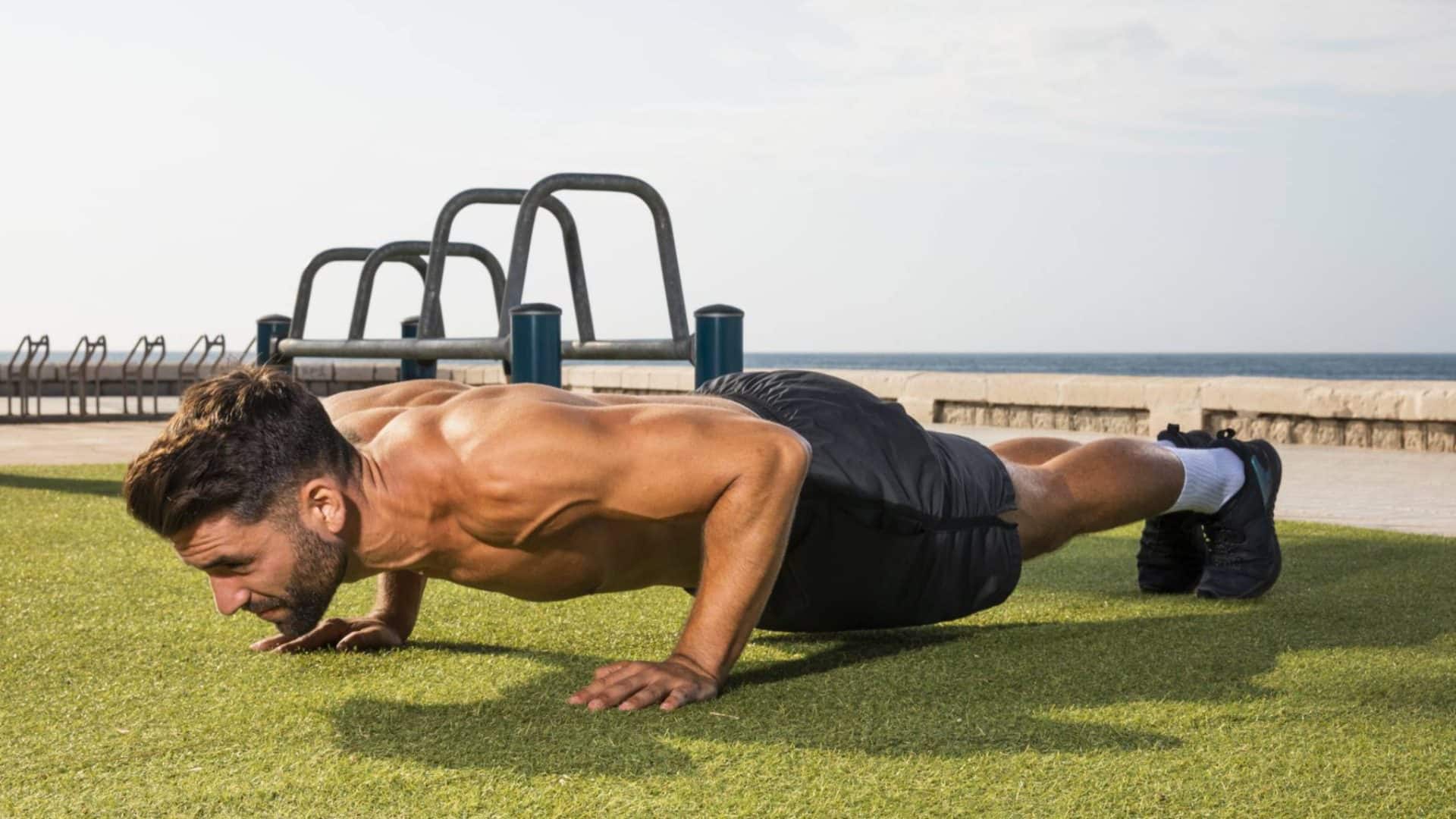
- Benefits of Push-ups
- What Muscles Do Push-Ups Work
- Pectorals
- Triceps
- Deltoids
- Serratus Anterior
- Abs And Core Muscles
- Glutes
- Biceps
- Back Muscles
- Erector Spinae Muscles
- Leg Muscles
- Train Different Muscles During Push-Ups Variations
- Best Push Ups Variations With Muscle Activation
- 1. Wall Push Up
- 2. Incline Push-Up
- 3. Knee Push-Up
- 4. Diamond Knee push-up
- 5. Standard Push-Ups
- 6. Knuckle Push-Up
- 7. Stability Ball Push Up
- 8. Decline Push-Up
- 9. Medicine Ball Push-Up
- 10. Wide Push Up
- 11. Feet on stability ball Push-up
- 12. Dumbbell Push-Up
- 13. Narrow Grip Push-Up
- 14. Diamond Push Up
- 15. Spider-Man Push-Up
- 16. Shoulder Tap Push Up
- 17. Hindu Push-Up
- 18. Bosu Push Up
- 19. Fingertip Push Up
- 20. Single-Leg Push Up
- 21. One Arm Push-Up
- 22. Archer Push-Up
- 23. Pike Push Up
- 24. Clapping push-up
- 25. Handstand Push Up
- FAQs
- How fast should I do the push-ups?
- How many push-ups should I do as a beginner?
- Is it OK if I do push-ups every day?
- How often should I do push-ups?
- My wrists hurt doing the push-ups. What should I do?
- Can push-ups help improve my posture?
- Conclusion
- Disclaimer:
- Reference:
- 35 Best Push Ups Variations for Beginner, Intermediate and advanced
Benefits of Push-ups
When it comes to training the pecs, push-ups exercises are a perfect choice because:
- Push-ups will improve muscular endurance within the upper body, strengthen both muscles and bones.
- Push ups will boost your explosiveness. Don’t believe me? Wait until you’ve worked your plyo push-ups to the flying progressions, and you’ll see what I mean!
- The movements you’ll learn are highly functional. You’ll not only gain strength and size; you’ll become more powerful all around, your joints will stronger, and your core will tighten.
- Push ups require more balance that can lead to greater muscle fiber recruitment.
- Doing push-ups can be a powerful full-body workout and help to burn more calories. They use up a large amount of energy in a short period because the movements require large muscle groups to lift and hold much of the body’s weight.
- It will increase your flexibility, which will go a long way towards preventing injuries;
- As you’ll be moving your full body around, these drills will improve your metabolism, get you to burn more fat and help you achieve that mean and lean look.
What Muscles Do Push-Ups Work
Push-ups can be an excellent exercise for improving muscle strength and endurance. Adequate knowledge of push-up, anatomy, biomechanics, and variations helps to target the muscle as desired.
The following primary muscles are targeted during the standard push-up.
- Chest Muscles, or Pectorals
- Triceps
- Deltoid (Shoulders)
- Serratus anterior
However, push-ups require many other muscles in the body to work to keep the body in a rigid plank position. These muscles may include:
- Abdominal or core muscles
- Glutes
- Biceps
- Back muscles, including the latissimus dorsi, rhomboids, and Trapezius muscles
- Erector Spinae Muscles
- Leg muscles, including the hamstrings, quadriceps, calf, and shin muscles
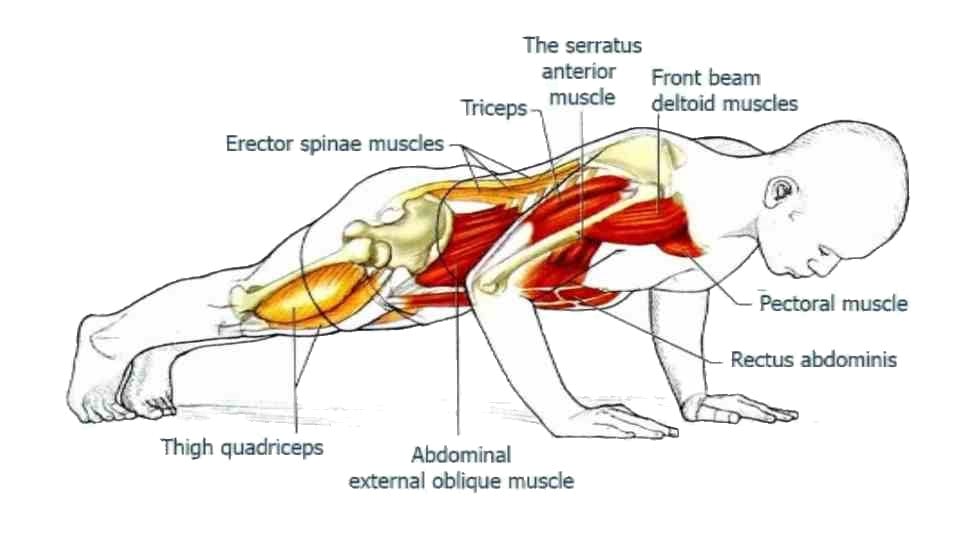
Pectorals
The pectoralis major (commonly referred to as “pecs”) is the fan-shaped muscle at the top-front area of the chest. A well-defined pectoral muscle is usually what makes a great chest.
It’s important to train the chest with a variety of exercises to develop
- Upper chest
- Lower chest,
- Inner pectorals.
- The outside Area of Pec
Triceps
The triceps brachii (commonly referred to as “triceps”), the large muscle located on the back of the upper arm, is responsible for the action of straightening the arm. The triceps muscle constitutes approximately 60 percent of the upper arm’s muscle mass.
The tricep is made up of three heads:
Note: For increased triceps development, perform push-ups with a narrow hand position
Deltoids
The deltoid muscle of the shoulder consists of three separate sections or heads.
- The anterior deltoid (In front)
- Lateral deltoid (at the side)
- Posterior deltoid (behind)
Even though push-ups are not a major contributor to deltoid development, they are still an ancillary benefit to this muscle. The deltoid muscles are involved in all movements of the upper arm, including lifting and rotation.
Serratus Anterior
The serratus anterior muscle originates on the surface of the upper ribs at the side of the chest and is largely responsible for the protraction of the shoulder blade.
Traditional pushups help to develop the serratus anterior, which is occasionally called the boxer’s muscle.”
Abs And Core Muscles
The core muscles, which comprise the rectus abdominis (abs), transverse abdominis, and obliques, play a pivotal role in stabilizing the spine and ensuring a robust and stable torso during push-ups.
Glutes
The gluteus maximus (commonly referred to as “glutes”) is the coarse muscle that makes up a large portion of the buttocks area and is largely responsible for maintaining the trunk in the erect posture.
Biceps
The biceps brachii (commonly referred to as “biceps”), the muscle located on the front of the upper arm, is responsible for forearm rotation and elbow flexion.
Back Muscles
The muscles of the back, including the rhomboids, trapezius, and erector spinae, help stabilize the scapulae and maintain proper posture throughout the exercise.
Erector Spinae Muscles
The erector spinae muscles, located on either side of the spine, are responsible for maintaining an upright posture and spinal extension during push-ups. They provide stability to the core and help prevent excessive spinal flexion.
Leg Muscles
Push-ups work on the upper body, but the muscles in the legs, like the quadriceps and glutes, also help keep the body stable and in control.
Train Different Muscles During Push-Ups Variations
Push-ups can be done in many different ways to work different muscles. They have numerous biomechanical variations that can alter muscle activity by lowering or increasing the challenge for the targeted muscle.
These variations typically involve altering the positioning of hands and feet and the angle of the body, which has a significant impact on muscle recruitment patterns and joint stresses.
The study has shown different levels of electromyography (EMG) activity in the pectoralis major and triceps muscles are required to perform push-ups from each of 3 different hand positions:
- Normal base (shoulder width): best for overall chest and tricep development.
- Wide base (150% shoulder width): activates the pectoralis major to a greater degree than the other positions,
- Narrow base (50% shoulder width): whereas, the narrow base optimizes the activation of the triceps brachii.
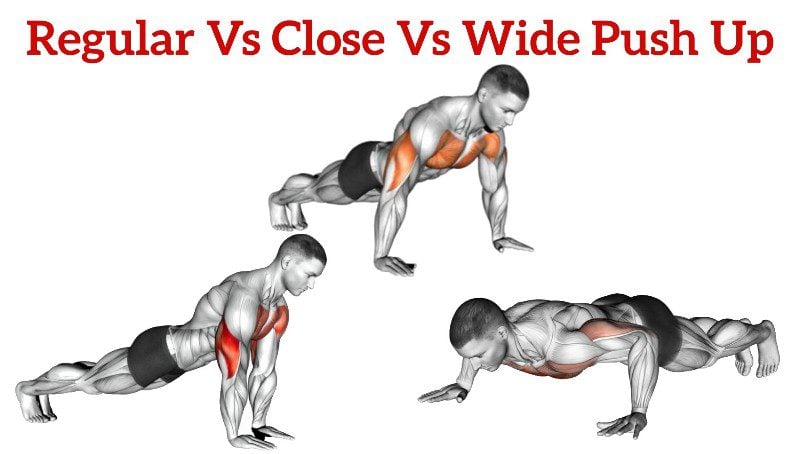
There are many ways to do push ups, including different foot positions and body angles. The most common ones are:
- Standard Push Ups: It helps you build your chest, shoulders, and tricep muscles.
- Incline Push Ups: Because of the angle, the Incline push up works your lower chest and core more.
- Decline Push Ups: On the other hand, it works the upper chest and front shoulders (delts) more than the regular or incline variation.
Other ways to do push-ups include using unstable surfaces, suspension training devices, and specially designed push-up equipment.
According to a 2020 study on shoulder muscle activity during various push-up variations, the triceps, and pectoralis major muscles showed the highest electromyography amplitude during push-ups on unstable surface, suspension push-ups, stability ball push-ups.
- Push-ups with the hands on a stability ball made the triceps brachii work harder.
- Suspended push-ups are a highly effective way to stimulate abdominal muscles.
- During push-up plus, the serratus anterior muscle displayed the highest electromyography amplitude.
Best Push Ups Variations With Muscle Activation
The great thing about push-ups is that it will be difficult for you and your body to get used to them. There are many varieties that target each muscle a little differently.
Here are the Best Push-Ups variations for beginner, Intermediate and Advance.
1. Wall Push Up
The “wall” push-up dramatically reduces the pressure on the arms, upper back, and abs.
The closer you stand to the wall, the easier it is to perform, but remember, it’s still important to be aware of your body alignment as you perform this push-up.
Wall Push Ups Muscle Worked
- When doing wall push-ups, the main muscles that are worked are the chest, anterior deltoids, and triceps.
- The secondary muscles involved include the biceps rhomboids, and serratus anterior.
- Additionally, various stabilizing muscles, such as the core muscles, erector spinae and gluteal muscles, are engaged to maintain proper body alignment and stability during the exercise.
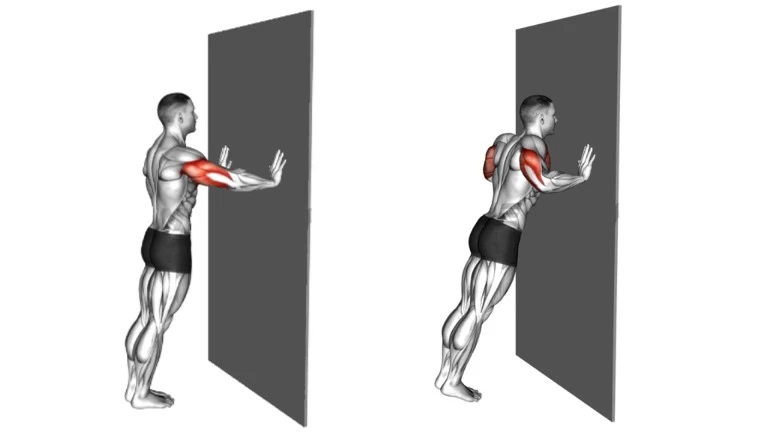
How to do Wall Push-Ups
- Stand approximately 2 to 2.5 feet away from the wall with your arms held at shoulder height in front of you.
- Place your hands against the wall with your body straight and your legs a few feet behind, so that your body draws a triangle together with the wall and the floor.
- Keeping your feet firmly fixed to the ground, lean your body forward so that your elbows flex and your chest comes within inches of the wall.
- Using your hands, push your body back into a standing position.
Tips For Proper Form
- The movement should be smooth and controlled.
- Try not to flare your elbows to the sides.
2. Incline Push-Up
Incline push-ups serve as a stepping stone for those who are new to push-ups or have limited upper body strength. The elevated position reduces the intensity, allowing you to gradually build strength and confidence.
Incline push-ups still target the chest, shoulders, and triceps like standard push-ups, but with a greater emphasis on the lower chest and shoulders.
Incline Push-Up Muscle Worked
In varying degrees, the muscles will be worked with greater or lesser intensity, depending on the degree to which you perform this exercise.
- Main muscles during incline push ups: Lower Chest, Anterior deltoids (shoulder muscle), and triceps.
- Secondary muscles during incline pushups: The upper chest, lateral deltoid, serratus, trapezius, and core muscles.
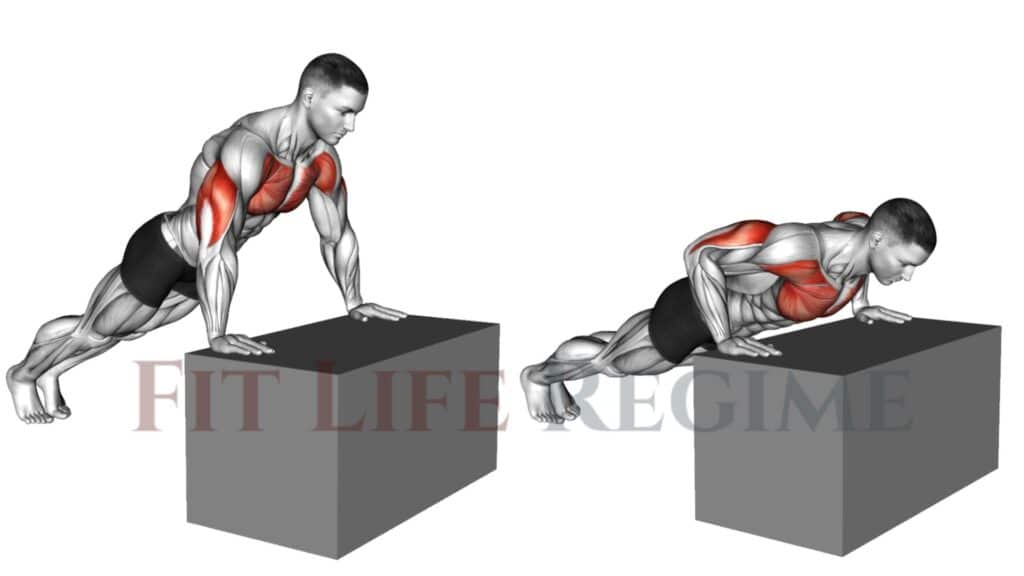
How To Do Incline Push Up
- Stand approximately 3 to 3.5 feet away from a low bench or sturdy chair.
- Reach forward and grab the sides of the chair or in front of the bench, keeping the balls of your feet in contact with the ground.
- Slowly lower yourself by flexing your elbows so that your chest comes within a few inches of the edge of the chair or bench.
- Using your hands, push yourself back to the starting position while focusing on maintaining a straight body position from head to ankle.
- The movement should be smooth and controlled.
Tips For Proper Form
- Exhale while you exert.
- Stand at a comfortable distance from the bench.
3. Knee Push-Up
The knee push-up, also known as a modified type push-up, is a bodyweight exercise that works for muscle groups throughout your upper body.
The knee push-up is a brilliant exercise for beginners. If you’re having trouble performing a full push-up, practice an easier push-up variation, the knee push-up.
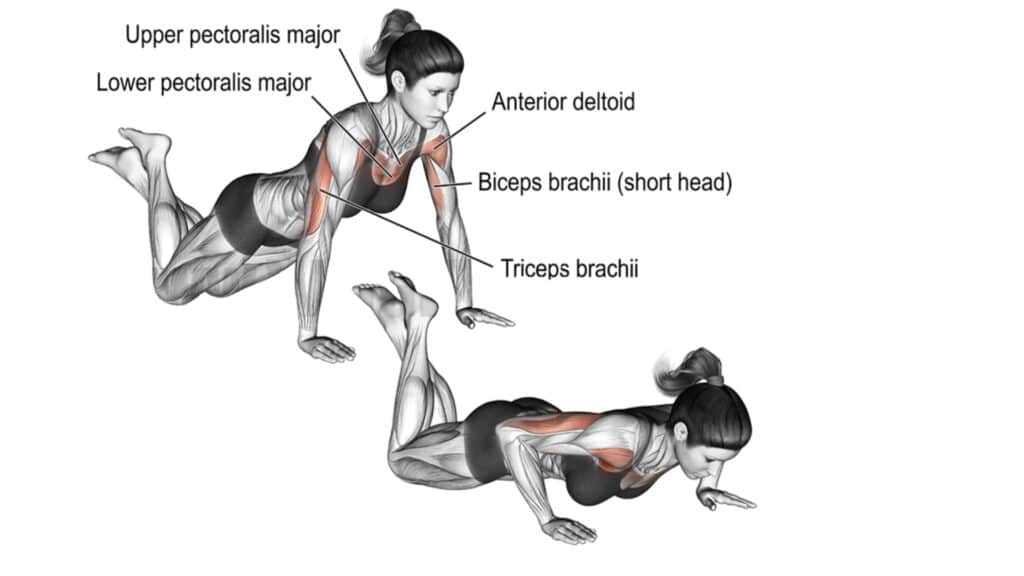
How To Do Knee Push-Ups
- Kneel on the floor. Extend arms and put hands shoulder-width apart on the floor in front of you.
- Lower yourself by flexing your elbows so that your chest comes within a few inches of the floor, making sure your body is in a straight line from your head to your knees.
- Raise your body to the starting position by pushing up with your arms.
- Repeat the desired number of repetitions.
Tips For Proper Form
- Focus on keeping your muscles active even when you’re lowering to the floor.
- Keep your back straight — never rounded! — throughout the move.
- Tighten your abs and butt to work your core during push-ups.
4. Diamond Knee push-up
The diamond push-up on the knees is a brilliant beginner exercise for the development of the triceps brachii.
Once the diamond push-up on knees becomes easy, graduate to performing the exercise on your hands and forefeet.
Muscles Worked During Diamond Knee Push Ups
Several muscles work together to execute the diamond push-up.
- The primary muscle worked during diamond knee push ups is the triceps.
- The secondary muscles include the pectoralis (chest) muscles, deltoids (shoulders), and serratus anterior.

How to do Diamond Push-Ups on Knee
- Get into a push-up position, supporting your body on your hands and knees instead of on your hands and forefeet.
- Your hands should be positioned in such a way as to form a diamond shape with your thumbs and index fingers.
- Keeping your body straight and rigid and your elbows close to your body, inhale as you lower your chest to the floor.
- Exhale as you extend your elbows and push your body back up to the starting position.
Tips For Proper Form
- Keep your elbows tucked in to your body
- Keep your body straight and rigid.
5. Standard Push-Ups
Check how to do them correctly and blast your muscles at home or at the gym. It is used to be done to build muscle and strength in the chest, shoulders, and arms.
Push-Ups can be a real challenge if done in various forms. Intensity is the key here to building muscle and Strength.

How to do Standard Push-Ups
- Lay face down on the ground with your legs straight, and arms supporting your upper body. Keep your knees off the ground.
- Raise yourself off the ground, straightening your elbows and your arms. But keep your elbows close to your body.
- Raise until your elbows are locked, and pause for a moment at the top of the movement.
- Now, lower your body under slow sustained motion, feeling the motion all the way down until your chest is very close to the ground.
Tips For Proper Form
- Exhale while you exert.
- For more variations, you do incline push-ups, decline ups.
6. Knuckle Push-Up
Knuckle push-ups are a variation of the standard push-up where you perform the exercise on your knuckles instead of with your palms flat on the ground
During Knuckle Push-Ups, the pressure is placed on your knuckles instead of your extended wrists.
If you experience pain in your wrists while doing standard push-ups, doing Push-Ups on your knuckles may be a good way to get the benefits without the wrist pain.
Knuckle Push-Up Muscle Worked
- During knuckle push-ups, the primary muscles worked are the chest muscles, anterior deltoids, and triceps.
- The knuckle position also engages the muscles of the forearms and wrists, including the flexor and extensor muscles.
- Additionally, the core muscles (abdominal and obliques) and stabilizing muscles of the back are activated.
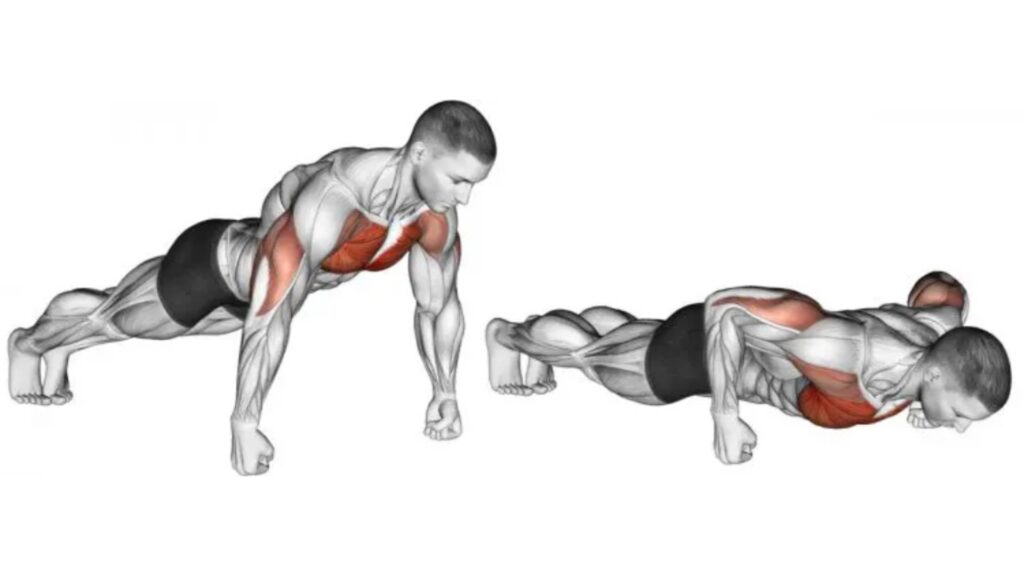
How To Do Knuckle Push Ups
- Assume a standard push-up position, but place the knuckles of your fists on the floor perpendicular to the body.
- Perform a traditional push-up by keeping your body in a straight line while pushing yourself up, until your arms are fully extended.
- Slowly lower yourself back down to the starting position.
Tips For Proper Form
- Perform on an exercise mat to avoid any discomfort on your hands.
- Don’t let your hips sag. Your body should be in a straight line throughout the movement. Push-ups are a great core exercise.
- Keep your back, shoulders, and feet in a straight line.
7. Stability Ball Push Up
Using a Swiss ball (or exercise ball) can bring an extra element to push-ups, giving you an uneven surface to increase the difficulty.
You’ll have to focus on maintaining your balance on the ball, which allows you to work more than you would be performing the standard, floor-bound version of the classic move.
Muscle Worked During Stability Ball Push Up
- During stability ball push-ups, the primary muscles worked are the pectoralis major, anterior delt, and triceps.
- The unstable nature of the stability ball also engages the core and lower back muscles for stability and balance.
- The forearms and wrists are also activated to maintain control and balance.
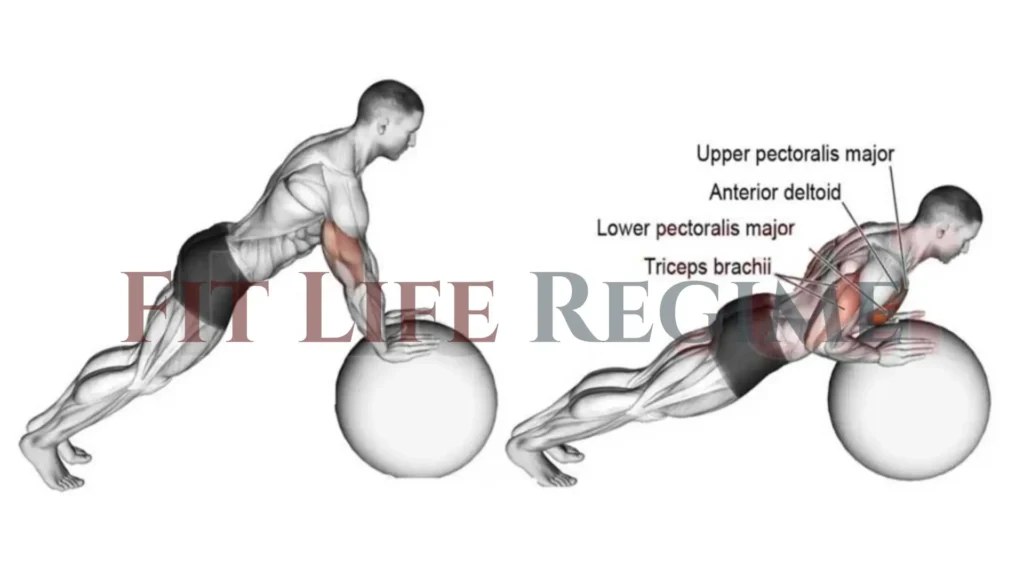
How to do Stability ball Push-Ups
- Lay with your chest on the stability ball. Place your hands on the ball at the sides of your chest. They will be shoulder-width apart.
- Place feet back and lean forward so that your chest is directly over the ball, and you are supported on your toes.
- Push your body up, until your arms are almost straight (do not lock your elbows). Pause here for a second.
- Breathe out and extend your arms to bring your upper body back to the starting position.
- Repeat for the desired number of repetitions.
Tips For Proper Form
- Keep your glutes and core muscles contracted.
- Your neck should be in line with your body, not tilted up, which could strain the neck.
8. Decline Push-Up
Decline Push-ups are similar to normal push-ups, but with your legs on a bench. Although this is called the Decline push-up, it focuses more on the upper pecs.
Furthermore, your lower body is raised from the floor, the resistance your body provides is increased compared to doing the push-up on the floor. The decline type of push-up is harder than the standard push-up.
Decline Push Up Muscles Worked
Because of your body’s position, the decline push up emphasizes your upper chest (clavicular head of the pectoral) while also working your front deltoids, triceps, and serratus anterior.
- Main muscles during decline push ups: Upper Chest, Anterior deltoids (shoulder muscle), and triceps.
- Secondary muscles during decline pushups: Lower chest, lateral deltoid, serratus, trapezius, and core muscles (abs, lumbar, gluteal, pelvic, and deep spinal muscles).
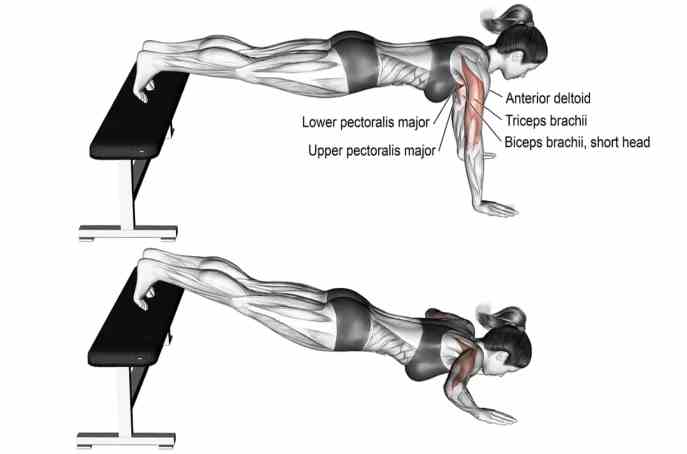
How To Do Decline Push Ups
- Placed your hands firmly on the floor and spaced slightly wider than shoulder-width apart. Put legs on the bench or the pad roller.
- Now raise yourself off the ground, straightening your elbows and your arms. Keep your elbows close to your body.
- Raise until your elbows are almost near to locked, and pause for a moment at the top of the movement.
- Now lower your body under slow sustained motion, feeling the motion all the way down until your chest is very close to the ground.
Tips For Proper Form
- Exhale while you exert.
- Vary the position of the bench to hit different angles of the upper chest.
9. Medicine Ball Push-Up
The close-grip medicine ball push-up is a strength exercise that works the chest and shoulders, with a little more focus on the triceps. The instability of the ball improves core strength and stability.
Doing push-ups with your knees bent on the floor or placing a medicine ball on a higher platform can both reduce resistance. You can substitute a brick for a medicine ball.
Medicine Ball Push-Up Muscle worked
- The triceps, pectoralis major, and anterior delt are the primary muscles engaged in medicine ball push-ups. The close grip position places more emphasis on the triceps compared to traditional push-ups.
- Additionally, the core muscles are engaged for stability and balance.
- The muscles of the forearms and wrists are engaged to ensure control and stability.

How To Do Close Grip Medicine Ball Push-Up
- Get in the standard push-up position with your hands on a medicine ball directly beneath your chest.
- Your left thumb and forefinger should touch your right thumb and forefinger.
- Bend your elbows to lower yourself in a controlled manner.
- Maintain a rigid core as your chest moves towards the top of the ball.
- Hold for one to two seconds before breathing out, extending your arms and pushing your body back to the starting position.
- Repeat the desired number of repetitions.
Tips For Proper Form
- Focus on maintaining balance during both phases.
- Your elbows should be tucked at your sides, not flared out.
- Do not attempt stability push-ups until you can do 20 basic push-ups.
10. Wide Push Up
Wide push-ups are a variation of the standard push-up where your hands are positioned wider than shoulder-width apart.
This variation targets the chest muscles (pectoralis major) to a greater extent, while still engaging the shoulders, triceps, and core. The wider hand placement helps to strengthen the outer chest muscles, resulting in a broader and more defined chest.
If you’ve mastered regular pushups and want to target your muscles a little differently, wide pushups are a suitable option.
Muscles Worked During Wide Grip Push Up
Several muscles work together to execute the wide hand push-up.
- The primary muscle worked during wide push up is the pectoralis (Mainly Outer Chest)
- The secondary muscles include the muscles, deltoids (shoulders), tricep and serratus anterior.
- Aside from the upper extremity muscles, wide grip push-ups in general, engage the core, glutes, hamstrings, quadriceps femoris and calf muscles as well.

How To Do Wide Grip Type Push Up
- Lay face down on the ground with your legs straight, and arms supporting your upper body.
- Put your arms in the 90/90 push up position.
- Slowly descend to the floor by retracting the shoulder blades and unlocking the elbows.
- Descend until the upper arms are parallel or your chest touches the floor.
- Push back to the starting point by extending the elbows and driving your palms into the floor.
Tips For Proper Form
- Remember to keep your back straight with your abs and glutes contracted at all times.
- Keep your chin down and don’t look forward.
11. Feet on stability ball Push-up
The push-up with feet on a Swiss ball is a progression of the decline push-up that targets the chest, shoulders, and triceps while engaging the core. The exercise emphasizes the upper chest and shoulders.
Feet on stability ball Push-up Muscle worked
- The primary muscles worked are the chest muscles, shoulder muscles, and triceps. The instability of putting the feet on a stability ball makes these muscles work harder to keep balance and control.
- The core and forearm muscles are engaged to stabilize the body and prevent excessive movement of the ball.
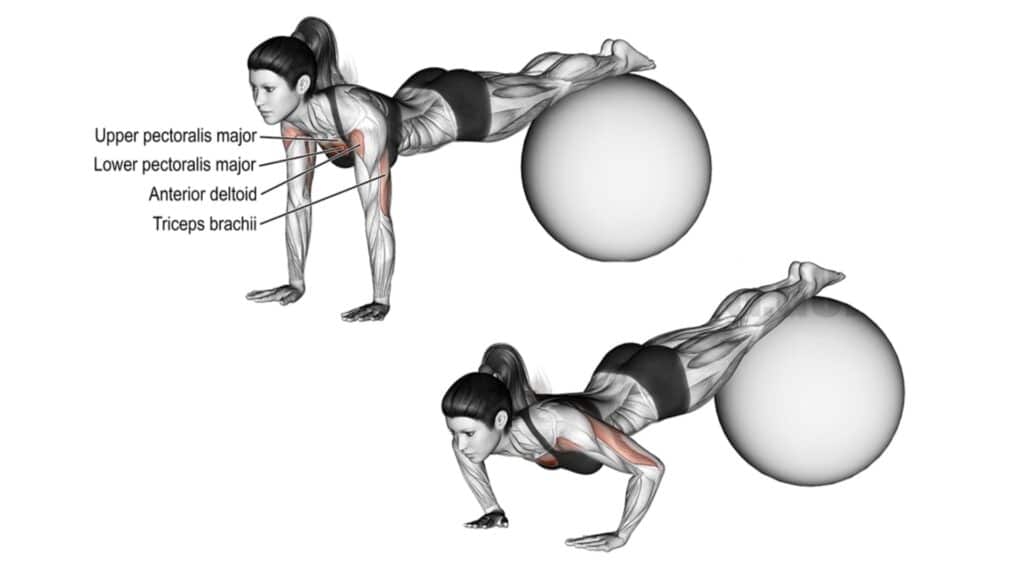
How to do Feet on stability ball Push-Ups
- Lie face-down on the ball with your arms supporting you in push-up position.
- Roll forward until your pelvis and thighs are off the ball, and position your feet on top of the ball.
- Your hands should be directly beneath your shoulders. And your body should form a straight line from head to heals.
- Breathe in as you lower yourself by bending your arms until your elbows form a 90-degree angle. Use your core muscles to stabilize yourself.
- Pause for one to two seconds at the bottom before breathing out and using your arms to push you up to the starting position.
Tips For Proper Form
- Keep your elbows tucked in at your sides.
- Core tight and your back flat throughout the movement.
- Keep your body in a straight line. Don’t allow your hips to sag or rise.
12. Dumbbell Push-Up
Dumbbell push ups target the same muscle groups as regular push ups, including the chest, triceps, and shoulders, but they can also provide an additional challenge by requiring additional stability and balance.
Using dumbbells for push-ups makes push-ups a more powerful exercise and helps you increase upper body strength, muscle mass, and overall balance.
Muscle Worked During Dumbbell Push Ups
- Dumbbell push-ups primarily work the chest muscles (pectoralis major and minor), as well as the triceps and the front of the shoulders (anterior deltoids).
- They also engage the core muscles, back muscles, serratus anterior as they help to stabilize the body during the exercise.
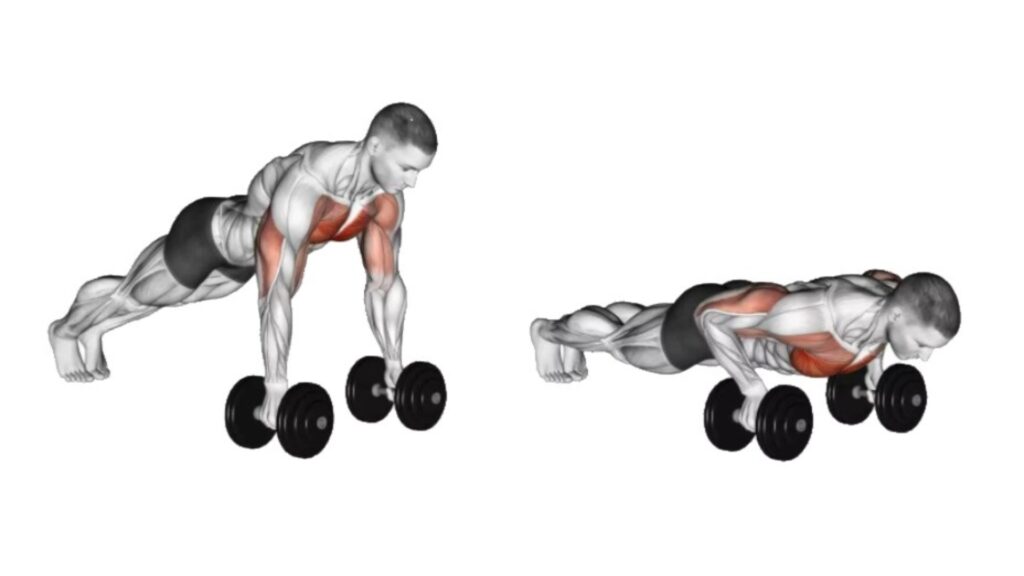
How To Do Dumbbell Push-Ups
- Place two dumbbells on the ground parallel to each other, slightly wider than shoulder-width apart.
- Assume a high plank position with your hands on the dumbbells, gripping them securely.
- Engage your core, squeeze your glutes, and maintain a straight line from head to heels.
- Lower your body towards the ground by bending your elbows, keeping them close to your sides.
- Aim to bring your chest as close to the ground as possible without touching it, while maintaining proper form.
- Pause for a moment at the bottom position.
- Then, push through the dumbbells, straighten your arms, and return to the starting position.
- Repeat for the desired number of repetitions while maintaining proper form.
Tips For Proper Form
- Exhale while you exert.
- Brace your core throughout your chest workout to keep it engaged.
13. Narrow Grip Push-Up
There are several benefits that can be gained from adding the narrow push-up to a workout routine. It includes an increase in triceps and chest activity, an improvement in core strength and stability, and an enhancement of shoulder strength.
Close hand push-ups, often referred to as narrow grip push-ups. Close push-ups are done by positioning the hands close to each other. It is one of the more challenging variations of the push-up because of the narrower base of support.
Close Push Up Muscles Worked
Several muscles work together to execute the close grip push-up.
- During narrow Push-Ups, the main muscle that is used is the triceps brachii.
- Secondary muscles include the pectoralis, deltoids, and serratus anterior.
- Close hand push-ups also work the core, glutes, hamstrings, quadriceps femoris, and calf muscles.

How to do Narrow Grip Push-Ups
- Lay face down on the ground with your legs straight, palm near, and arms supporting the upper body. Keep your knees off the ground. Take a narrower push up stance than you normally would.
- Now raise yourself off the ground, straightening your elbows and your arms but keep your elbows close to your body.
- Raise until your elbows are locked, and pause for a moment at the top of the movement.
- Now lower your body under slow sustained motion, feeling the motion all the way down until your chest is very close to the ground.
Tips For Proper Form
- Exhale while you exert.
- For intensity and variation, do the decline variation.
14. Diamond Push Up
Diamond push-ups, also known as triangle push-ups, are a more advanced type of the classic push-up. You can practice diamond push-ups by bringing your hands too close together to form a diamond or triangle shape below your chest.
There are several benefits that can be gained by adding the diamond push-up to your workout routine. This includes an increase in triceps and chest activity, improvement in core strength and stability, and enhancement of shoulder strength.
Muscles Worked During Diamond Push Ups
Several muscles work together to execute the diamond push-up.
- In diamond push ups, the primary muscle worked is the triceps.
- The secondary muscles include the pectoralis (chest) muscles, deltoids (shoulders), and serratus anterior.
- Aside from the upper extremity muscles, diamond push-ups in general, engage the core, glutes, hamstrings, quadriceps femoris and calf muscles as well.
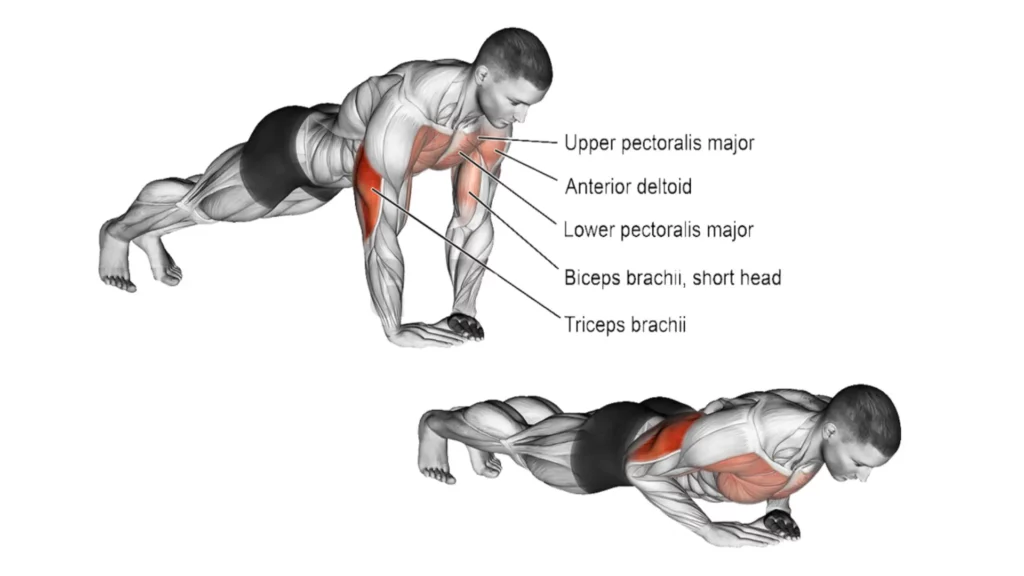
How To Do Diamond Type Push-Ups
- Get on all fours with your hands together under your chest.
- Position your index fingers and thumbs, so they’re touching, forming a diamond shape, and
- Now extend your arms so that your body is elevated and forms a straight line from your head to your feet.
- Lower your chest towards your hands, ensuring you don’t flare your elbows out to the sides and keeping your back flat.
- Stop just before your chest touches the floor, then push back up to the starting position.
Tips For Proper Form
- Keep your body straight and rigid.
- To make the diamond push-up easier, do it on your knees.
15. Spider-Man Push-Up
The Spider-Man Push-up is a great type of push up if you’re getting tired of the standard push-up and need a challenge. This exercise is primarily chest and arm strengthening, but it also increases hip flexibility and really works your core too.
In a Spider-Man push-up, the performer brings one knee to the elbow, creates a dynamic movement that challenges the core and improves stability, it also engages the shoulders and back muscles, making it a full-body exercise.
Muscles Worked During Spiderman Push Up
The Spider-Man push up is a compound exercise that targets multiple muscle groups, including:
- They primarily work the chest muscles, as well as the triceps and the shoulders (deltoids).
- They also engage the core muscles, back, as they help to stabilize the body during the exercise.
- Furthermore, it is worth mentioning that the legs and glutes are worked as you bring your knee to your elbow
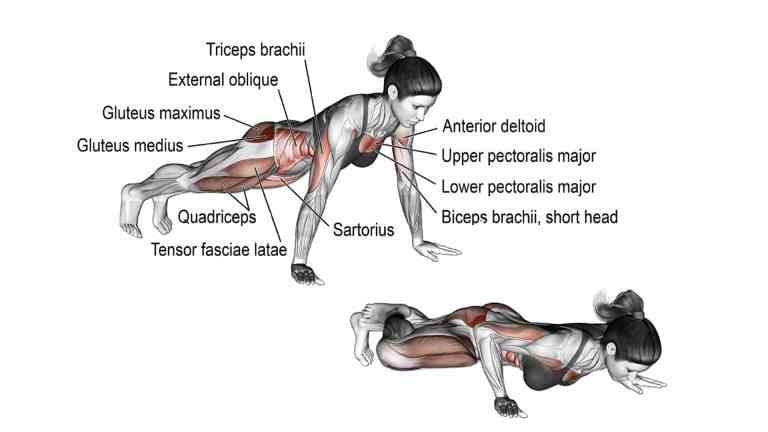
How To Do Spiderman Push-Ups
- Start in a high plank position with your hands flat on the floor about shoulder-width apart, wrists under shoulders.
- Keeping your body in one long line, bend your arms and lower yourself as close to the floor as you can.
- As you lower your body, bend one leg out to the side and bring your knee toward the same-side arm.
- Push back up to start, and straighten your leg back out. Repeat alternating sides.
Tips For Proper Form
- Keep your knees high and away from the floor, and make sure that your movement is well-coordinated.
- Do not let the elbows flare out. Keep the elbows close to your sides throughout.
16. Shoulder Tap Push Up
The shoulder tap push-up is a variation of the push-up that challenges the core to a greater extent than its traditional counterpart.
Once you can do at least 10 full push-ups, you should be able to start incorporating some shoulder taps into the mix.
Shoulder Tap Push Up Muscle Worked
The shoulder tap push-up is a compound exercise that works multiple muscle groups at the same time.
- The main muscles that are targeted are the pectoralis major, deltoids, and tricep.
- Doing a shoulder tap push-up not only works your main muscles, but also your core muscles like your six-pack, obliques, and transverse abdominis to maintain proper body alignment and stability.
- Furthermore, the muscles of the scapulae and back, such as the rhomboids, trapezius, and latissimus dorsi, are involved in keeping the shoulder girdle stable.
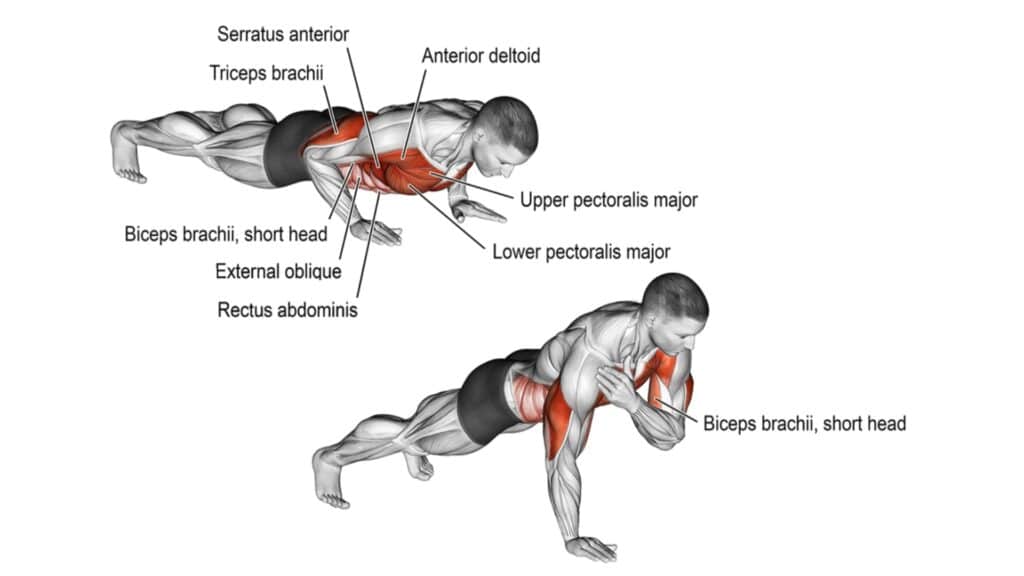
How To Do Shoulder Tap Push-Ups
- Get in the standard push-up position
- Lower yourself by flexing your elbows so that your chest comes within a few inches of the floor.
- Raise your body to the starting position by pushing up with your arms. Tap your left hand to your right shoulder while engaging your core and glutes to keep your hips as still as possible.
- Place it back on the floor and repeat your next push up and shoulder tap with another hand.
Tips For Proper Form
- Do not let your lower back sag or your butt rise. Ensure your body is straight and rigid.
17. Hindu Push-Up
The Hindu push up is a traditional Indian-style exercise practiced by wrestlers. Each repetition includes going from a downward dog position to a cobra pose, swooping by holding the head and body close to the ground.
Unlike conventional push-up, Hindu pushups aren’t concentrating majorly on the chest muscle. Instead, Hindu push-up is an incredible exercise to develop stronger shoulders, pectoral, arms, core, and spine.
Hindu Push-Ups Muscled Worked
The Hindu push-up has stood the test of time and is the single most effective exercise for simultaneously strengthening the following muscles:
- Chest muscles,
- Shoulders muscles
- Back muscles,
- Triceps
However, Hindu push-ups require many other muscles in the body to work to keep the body in a position.
- Lower back muscles
- Abs, or core muscles
- Leg muscles

How To Do Hindu Push Ups
- Start in a downward dog pose, with your hands shoulder-width apart, your body in a V shape, and your feet hip-width apart.
- Bend your elbows and lower your chest until it’s just above the floor, going into low plank pose.
- In a scooping motion, scoop your head upward while arching your lower and upper back and go into cobra pose.
- To return to the starting position, you do not need to reverse back through the sweeping, arching motion.
- Simply push back into the starting position.
Tips For Proper Form
- Engage your core, relax the spine and neck, open the shoulders and keep the movement smooth.
- keep the elbows close to your body.
- Remember to breathe correctly as you do the push-ups.
18. Bosu Push Up
The Bosu push-up is a variation of the traditional push-up exercise that incorporates the use of a Bosu ball. The Bosu ball, which stands for “Both Sides Up,” is a half-sphere stability training device with one side flat and the other side inflated.
Performing push-ups on a Bosu ball requires greater core stability and engagement. The unstable surface challenges your core muscles to work harder to maintain balance and control.

How to do Bosu Push Up
- Place the Bosu ball on the floor with the inflated side facing down.
- Position yourself in a push-up position with your hands slightly wider than shoulder-width apart on the flat side of the Bosu ball.
- Engage your core muscles and maintain a straight line from your head to your heels.
- Lower your chest towards the Bosu ball by bending your elbows, keeping them close to your body.
- Pause briefly when your chest is close to the Bosu ball.
- Push back up to the starting position by extending your arms fully.
- Repeat for the desired number of repetitions.
Tips For Proper Form
- Keep your body in a straight line, engage your core, and avoid sagging or arching your back.
- Perform each rep in the controlled manner.
- Do not attempt stability push-ups until you can do 20 basic push-ups.
19. Fingertip Push Up
Doing push ups on your fingertips can look impressive, and it’s also an efficient exercise to increase your grip for basketball, bodybuilding, or rock climbing.
The fingertip push up also keeps your wrists straight, making it an excellent way to eliminate wrist pain from the 90-degree bend when your palms are flat on the floor.
Fingertip push-ups can be dangerous without perfect form. You feel it would be better not to risk an injury to your fingers if they aren’t ready to support your weight.
Fingertip Push Up Muscle Worked
- During fingertip push-ups, the main muscles being worked are the chest, deltoids, and triceps.
- It also engages the muscles of the forearms. These muscles are responsible for finger flexion and grip strength.
- Moreover, the muscles of the core are used to keep the body straight and stable.
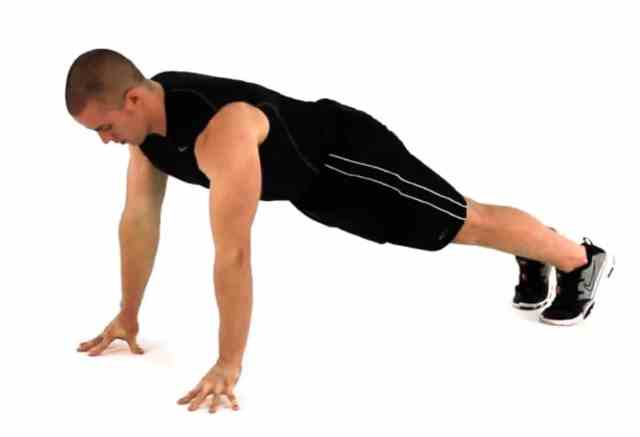
How to do Finger Push-Ups
- Use only your fingertips to perform a push-up instead of having your hands flat on the ground.
- Your hands should be slightly wider than shoulder-width apart.
- As you breathe in, lower your torso to the ground until your chest is an inch or two from the ground. Keep your elbows close to your body.
- Breathe out as you push yourself up using your arms. Think of raising yourself by attempting to push the ground away from you.
- Repeat for the desired number of repetitions.
Tips For Proper Form
- Spread your fingers apart slightly for balance
- Perform on an exercise mat to avoid any discomfort on your fingers.
- Don’t allow your hips to drop. Keep your body in a straight line.
20. Single-Leg Push Up
The single-leg push-up is one of the most challenging types of the push-up.
The only possible way to complete this movement is with proper stability from your feet up through to your head.
Single-Leg Push Up Muscle worked
Single-leg push-ups, you not only target the upper body pushing muscles, but also challenge the strength and stability of the lower body and engage the core muscles for balance and control.
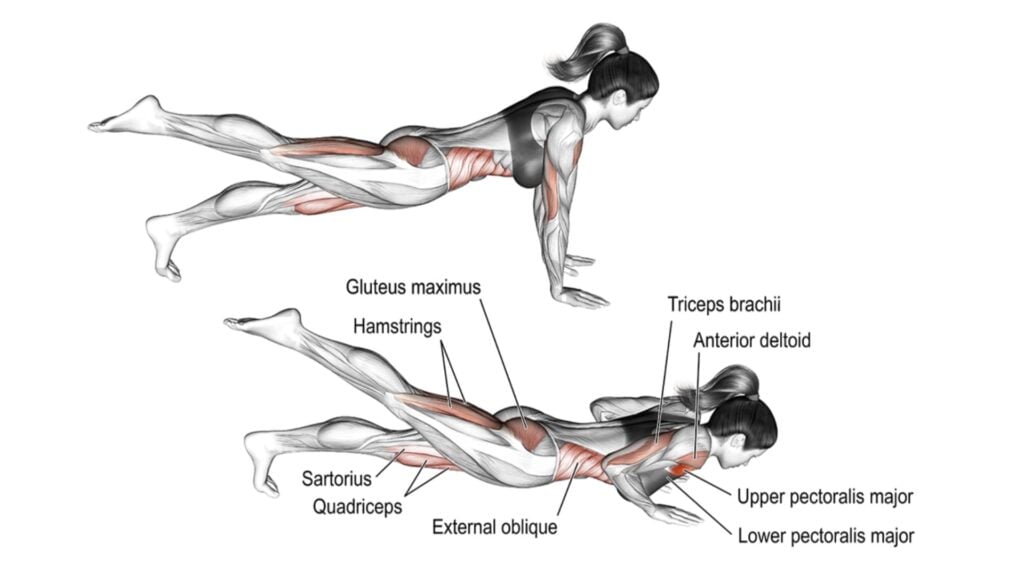
How To Do Single Leg Push-Ups
- Assume a standard push-up position, but place one foot on top of the other or one place one foot in the air straight behind you.
- Lower yourself by flexing your elbows so that your chest comes within a few inches of the floor.
- Make sure your body is in a straight line from your head to your toe and you one leg in the air.
- Raise your body to the starting position by pushing up with your arms.
- Repeat the desired number of repetitions.
- Make sure to alternate legs in between sets or repetitions to create a symmetrical body.
Tips For Proper Form
- To preserve shoulder health, keep your elbows slightly tucked into your body.
- Your neck should be in neutral alignment with the head in a straight line with the spine, from the top of your head to the feet.
21. One Arm Push-Up
A one-arm push-up is a compound exercise that requires far more strength and balance than a standard push-up using two arms. This variation allows you to train unilaterally (one side of your body at a time), which is typically an option with traditional pushups.
It just might be one of the most difficult body-weight exercises to master.
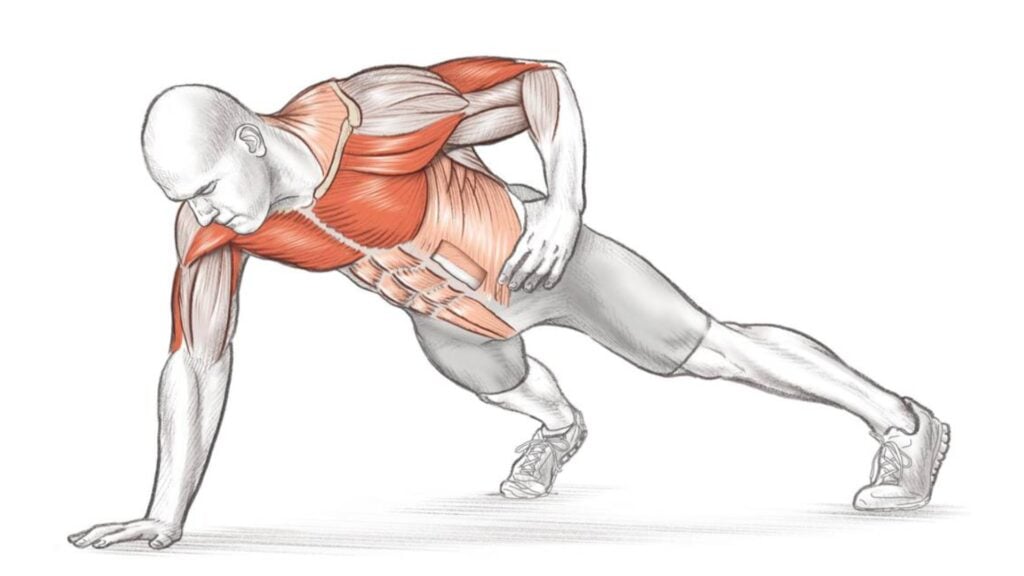
How To Do One Arm Push-Ups
- Get in the standard push-up position.
- Place one hand on the ground directly beneath your chest and the other behind your lower back.
- To maintain balance, turn your torso slightly away from the pushing arm.
- Breathe in as you lower your angled torso to the ground until your chin is a few inches above the floor.
- Breathe out as you push yourself up from the floor. Stop just before you lock out your elbow at the top of the movement.
Tips For Proper Form
- keep your core tight and back flat throughout the movement.
- Do not rotate your arm outwards from your chest, as it will put additional stress on the elbow that can lead to discomfort and injury.
22. Archer Push-Up
The Archer Pushups are different from regular Pushups because you use one hand to do the exercise and the other hand to help you.
This means that the chest, shoulder, and triceps muscles on one side are being worked, while the other side is helping to hold the body together. This allows you to train one side with greater focus and intensity.
What muscles do Archer Pushups target?
Archer push-ups work your triceps, pecs, and anterior deltoids more than regular push-ups because they use a wider range of motion.
The archer push-up also works several secondary muscles, such as the bicep, rhomboids serratus anterior, and the core muscles.
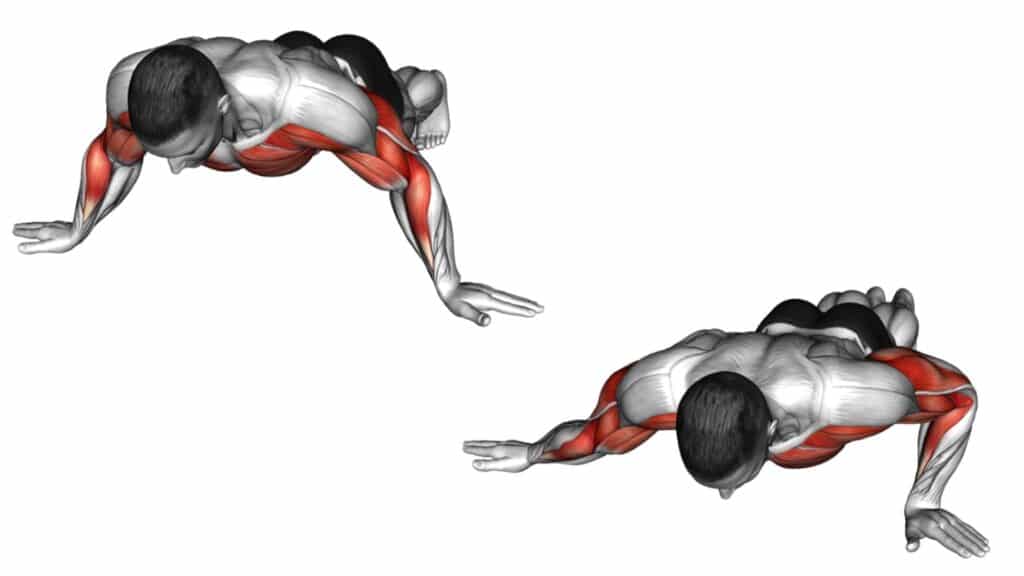
How To Do Archer Push-Ups
- Start in a standard push-up position.
- Maintain a strong core position and shift your upper body toward your right side.
- Pull your right chest toward your right hand as you bend your right elbow.
- As you lower toward the right side, allow your left arm to straighten.
- Your left arm should be fully extended, forming a straight line from your shoulder to your hand.
Tips For Proper Form
- Don’t let your hips raise.
- Make sure your body is in the straight line from head to the feet.
23. Pike Push Up
Pike Push-ups are a type of the push-up that increases strength and stability in the shoulders and triceps. Performing the exercise in a more upright position will target the shoulders more than the chest.
The inverted position of the pike push-up can help to stretch and lengthen the muscles in the shoulders and upper back, increasing flexibility in these areas.
Pike Push Up Muscles Worked
- Pike push-ups primarily target the muscles in the shoulders, specifically the deltoids, as well as the triceps.
- They also engage the core muscles as well as back muscles.
- Additionally, pike push-ups can also work the muscles in the legs, including the quadriceps, glutes, and hamstrings.
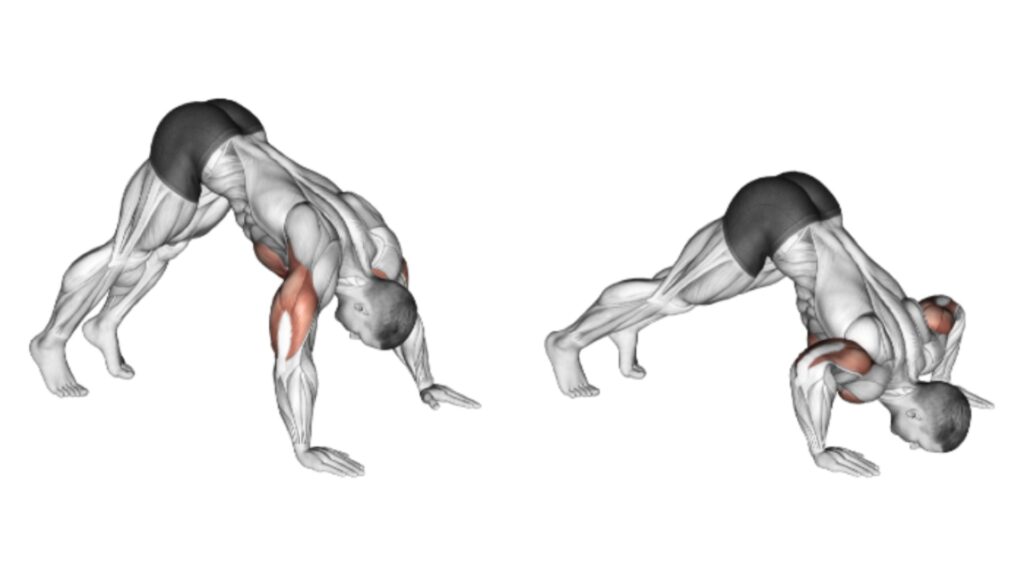
How To Do Pike Push-Ups
- Start in a standard push-up position.
- Lift the hips up and back until your body forms an inverted V shape. Keep arms and legs as straight as possible.
- Slowly lower the top of your head towards the ground. Once your head is about to contact the ground, pause for a second.
- Then slowly push back until your arms are straight, and you’re in the inverted V position.
Tips For Proper Form
- Make sure you maintain control throughout the movement.
Read More: 5 Best Shoulder Push-Ups To Build Strength & Mass
24. Clapping push-up
Clapping Push-ups aka Plyometric (plyo) push up is an advanced exercise that works your chest, triceps, abs, and shoulders. With this type of push up, a “jumping” element is added to the exercise to make it more challenging and explosive.
Plyo push ups can help burn fat and build muscle. Many athletes perform them to help improve their athletic performance by building strength, endurance, and speed.
Clap Push-Ups Muscles Worked
- Clap push-ups work the pectorals, anterior deltoid head, and triceps brachii as the main mover muscles.
- Both the serratus anterior and medial deltoid heads are secondary mover muscles.
- While the abdominal muscles, forearms, and glutes act as stabilizers.

How to do Clapping Push-Ups
- Start with your palms flat on the floor, hands shoulder-width apart, shoulders stacked directly above your wrists, and legs extended behind you.
- Your body should form a straight line from your shoulders to your ankles. Brace your core by contracting your abs.
- Start to lower your body as if you’re going to do a push-up until your chest is almost touching the floor.
- Reverse the motion by pushing hard through the palms, just as your arms reach full extension, pull your hands up off the floor.
- Rapidly clapping the hands together and placing them back in the original position before your body falls back to the ground.
Tips For Proper Form
- Be sure to exhale when exploding off the ground and inhaling on the way down.
- Do not let the elbows flare out. Keep the elbows close to your sides throughout.
25. Handstand Push Up
The handstand push-up also called the vertical push-up is a type of push-up exercise where the body is positioned in a handstand. To prepare the strength until one has built adequate balance, the feet are often placed against a wall, held by a partner, or secured in some other way from falling. It requires significant strength, as well as balance and control if performed freestanding.
Handstand push ups increase the load on the triceps brachii muscles significantly over regular push ups, having the arms hold almost 100% of the body’s weight rather than an average of 60 to 70% during normal push ups.
Handstand push-up muscles worked
- During handstand push-ups, the primary muscles worked are the deltoids (especially the anterior deltoid), triceps and the muscles of the core.
- The secondary muscles involved include the trapezius, rhomboids, pectoralis major, erector spinae, and forearm muscles.
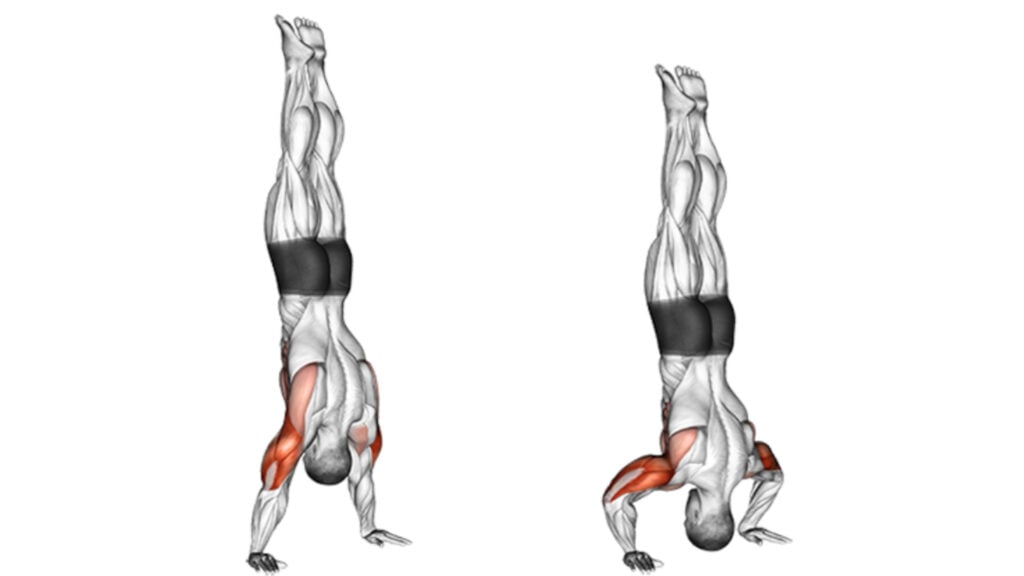
How to do Handstand Push Ups
- Place hands about 6-12 inches away from the wall and slightly wider than shoulder width apart. Make sure palms are facing forward, or slightly turned out 5-10 degrees.
- Kick up into a handstand, with your heels touching the wall. Once you have kicked up, establish a strong, rigid midline position.
- While maintaining this position, lower yourself until the top of your head touches the floor/mat. Try to keep your elbows at a 45-degree angle as you lower.
- Once your head touches the floor, press up with the same tightness you had lowering yourself, until your elbows reach full extension.
Tips For Proper Form
- Not to arch your back and keep contracting your abs.
- Do not do this move on consecutive days. Rest for at least 2 days before trying this move again to give your body time to recover.
- Point your toes, squeeze your glutes, and grip the ground with your fingertips for a better feeling of stability.
FAQs
How fast should I do the push-ups?
Push-ups should be performed in a slow, deliberate manner. Rather than bouncing up and down, it’s important to maintain full control as you lower and raise your body. As a rough guide, each phase—both up and down—of a single push-up should take a couple of seconds.
How many push-ups should I do as a beginner?
If you’re new to something, it’s best to start at a level you can handle. Start with a modified version of push-ups, such as knee push-ups or inclined push-ups. Aim to complete a comfortable number of repetitions. Increase the number of times you do each exercise as you get stronger.
Is it OK if I do push-ups every day?
No. It is very important to allow your body time to recover from the intense daily workouts. Muscle tissue is broken down during exercise, but will rebuild itself during periods of rest and recovery. Working the muscles on consecutive days will hamper the rebuilding process and limit your progress. Remember, the body needs 48 hours to recover and adapt to the stress of strength training.
How often should I do push-ups?
For general strength and fitness improvement, it is sufficient to perform push-ups two to three times a week. However, it’s essential to allow your muscles time to rest and recover between sessions.
My wrists hurt doing the push-ups. What should I do?
Try closing your hands and making a fist to perform the push-ups. This way your body weight ends up on your knuckles instead of your palms, thus avoiding the wrist extension motion. Please ensure that you do this type of pushups on a padded mat, plush carpet, or, even better, a folded towel.
Can push-ups help improve my posture?
Yes, push-ups can contribute to better posture by strengthening the muscles of your upper body, including the back, shoulders, and core. These muscles play a crucial role in maintaining proper posture and alignment
Conclusion
The push-up is a fundamental upper body exercise that has a prominent place in the training routines of athletes, fitness enthusiasts, and bodybuilders. Although it is commonly associated with targeting the chest muscles, it effectively engages multiple muscle groups, including the triceps, deltoids, and core.
Performing push-ups offers a range of notable benefits. One of the primary advantages of the exercise is the development of upper body strength, as it engages the major pushing muscles of the upper body.
The versatility of push-ups lies in the availability of various variations that can be incorporated to modify the exercise’s difficulty level based on one’s level of experience and strength.
Disclaimer:
The information contained in this article is for educational and informational purposes only and is not intended as health advice. We would ask you to consult a qualified professional or medical expert to gain additional knowledge, before choosing to consume any product or perform any exercise.
Reference:
- Behm D.G., Anderson K., Curnew R.S. (2002) Muscle force and activation under stable and unstable conditions. Journal of Strength and Conditioning Research 16(3): 416-422.
- Calatayud J., Borreani S., Colado J.C., Martin F., Rogers M.E. (2014) Muscle activity levels in upper-body push exercises with different loads and stability conditions. Physician and Sportsmedicine 42, 106-119.
- Clemons J. (2019) Construct validity of two different methods of scoring and performing push-ups. Journal of Strength & Conditioning Research 33, 2971-2980.
- Chulvi‐Medrano I, Martínez‐Ballester E, Masiá‐Tortosa L. Comparison of the Effects of an Eight‐Week Push‐Up Program Using Stable Versus Unstable Surfaces. International journal of sports physical therapy. 2012 Dec;7(6):586.Available: https://www.ncbi.nlm.nih.gov/pmc/articles/PMC3537455/ (accessed 16.11.2021)
- ↑ Cogley RM, Archambault TA, Fibeger JF, Koverman MM. Comparison of muscle activation using various hand positions during the push-up exercise. Journal of strength and conditioning research. 2005 Aug 1;19(3):628. Available:https://pubmed.ncbi.nlm.nih.gov/16095413/ (accessed 16.12.2021)
- Freeman S, Karpowicz A, Gray J, et al. Quantifying muscle patterns and spine load during various forms of the push-up. Med Sci Sports Exerc 2006; 38: 570–577.
- Cogley R.M., Archambault T.A., Fibeger J.F., Koverman M.M., Youdas J.W., Hollman J.H. (2005) Comparison of muscle activation using various hand positions during the push-up exercise. Journal of Strength & Conditioning Research 19, 628-633.
- Azeem K. The Push-Up. International Journal of Fitness, Health, Physical Education & Iron Games,(2). 2015 Jan;1.
- ↑ Yang J, Christophi CA, Farioli A, Baur DM, Moffatt S, Zollinger TW, Kales SN. Association between push-up exercise capacity and future cardiovascular events among active adult men. JAMA network open. 2019 Feb 1;2(2):e188341-.
- Borreani S, Calatayud J, Colado JC, et al. Shoulder muscle activation during stable and suspended push-ups at different heights in healthy subjects. Phys Ther Sport 2015; 16: 248–254.
- Borreani S, Calatayud J, Colado JC, et al. Muscle activation during push-ups performed under stable and unstable conditions. J Exerc Sci Fit 2015; 13: 94–98.
- Cogley RM, Archambault TA, Fibeger JF, et al. Comparison of muscle activation using various hand positions during the push-up exercise. J Strength Cond Res 2005; 19: 628–633
- Ebben WP, Wurm B, Vanderzanden TL, et al. Kinetic analysis of several variations of push-ups. J Strength Cond Res 2011; 25: 2891–2894. –
35 Best Push Ups Variations for Beginner, Intermediate and advanced

Manish brings over 10 years of hands-on experience in weight lifting and fat loss to fitness coaching. He specializes in gym-based training and has a lot of knowledge about exercise, lifting technique, biomechanics, and more.
Through “Fit Life Regime,” he generously shares the insights he’s gained over a decade in the field. His goal is to equip others with the knowledge to start their own fitness journey.
